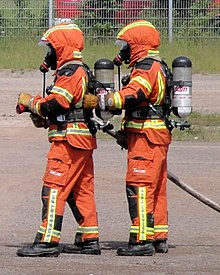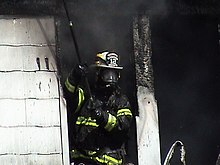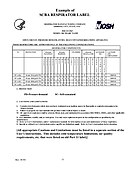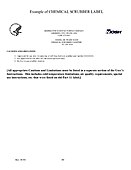Self-contained breathing apparatus
| Self-contained breathing apparatus | |
|---|---|
 | |
| Other name(s) | SCBA, compressed air breathing apparatus, breathing apparatus |
| Regulated by | National Institute for Occupational Safety and Health, National Fire Protection Association |
| Regulation | 42 CFR 84, EN 137, NFPA 1981 |
| NIOSH schedule | TC-13F |
| This article is part of a series on |
| Respirators in the United States |
|---|
| Executive agencies involved |
| Non-government bodies |
| Respirator regulation |
| Diseases mitigated by respirators |
| Misuse |
| Related topics involving respirators |
A self-contained breathing apparatus (SCBA) is a respirator worn to provide an autonomous supply of breathable gas in an atmosphere that is immediately dangerous to life or health from a gas cylinder.[1] They are typically used in firefighting and industry. The term self-contained means that the SCBA is not dependent on a remote supply of breathing gas (e.g., through a long hose). They are sometimes called industrial breathing sets. Some types are also referred to as a compressed air breathing apparatus (CABA) or simply breathing apparatus (BA). Unofficial names include air pack, air tank, oxygen cylinder or simply pack, terms used mostly in firefighting. If designed for use under water, it is also known as a scuba set (self-contained underwater breathing apparatus).
An open circuit SCBA typically has three main components: a high-pressure gas storage cylinder, (e.g., 2,216 to 5,500 psi (15,280 to 37,920 kPa), about 150 to 374 atmospheres), a pressure regulator, and a respiratory interface, which may be a mouthpiece, half mask or full-face mask, assembled and mounted on a framed carrying harness.[2]
A self-contained breathing apparatus may fall into one of three categories: open-circuit, closed-circuit,[3] or continuous-flow.[4]
Types
Closed-circuit

The closed-circuit type, also known as a rebreather,[5] operates by filtering, supplementing, and recirculating exhaled gas. It is used when a longer-duration supply of breathing gas is needed, such as in mine rescue and in long tunnels, and going through passages too narrow for a big open-circuit air cylinder. Before open-circuit SCBA's were developed, most industrial breathing sets were rebreathers, such as the Siebe Gorman Proto, Siebe Gorman Savox, or Siebe Gorman Salvus.[citation needed] An example of modern rebreather SCBAs would be the SEFA.
As of 1987, under 30 CFR 11
Duration of closed-circuit SCBAs is somewhere between 1-4 hours. A closed-circuit SCBA system is negative-pressure, increasing the risk of leaks.[5]
There are two types of closed-circuit SCBA according to NIOSH:
- Uses compressed oxygen.
- Uses an oxygen-generating solid. This involves a chemical reaction between potassium superoxide with exhaled water and carbon dioxide. A chlorate candle has to be struck to start the device.
To reduce pressure buildup from use, a pressure-relief valve with saliva trap is included. Closed-circuit SCBAs are also noticeably smaller than open-circuit ones.[5]
Self-contained self-rescue devices are also closed-circuit SCBAs, working on the same principles, being designed for emergency use in mines, and lasting about one hour.[5]
Open-circuit
As of 1987, under 30 CFR 11


An open-circuit SCBA does not recirculate air; it instead allows respired air to be exhausted outside. While 30 CFR 11 does not restrict the gas that can be used (although compressed air is usually chosen), use of compressed oxygen is not allowed due to the system's exposure to outside air. Duration is usually limited to 30-60 minutes.[6]
There are two types of open-circuit SCBA according to NIOSH:
- Demand: 2000 psi to the regulator from the main valve, plus a bypass valve in case of failure, with a two-stage regulator reducing pressure to 50-100 psi.
- Pressure-Demand: Similar to demand, but with a spring in the diaphragm, which holds the admission valve open, for continuous air flow to the facepiece.
NIOSH emphasizes that facepieces between both SCBA types cannot be interchanged, but certain SCBAs can be switched to both 'demand' and 'pressure-demand' operation. However, both modes require different training.[6]
Common traits

Open-circuit industrial breathing sets are filled with filtered, compressed air. Typical open-circuit systems have two stage regulators. The first stage reduces the pressure from storage pressure of up to more than 300 bar to about 10 bar for supply to the second stage on the mask, which further reduces it to just above atmospheric pressure via a demand valve when the pressure drops on inhalation. A positive pressure mask has the demand valve set to close when the pressure inside the mask is slightly above the external ambient pressure, so when the mask is removed from the face or leaks around the skirt, the demand valve will free-flow.[citation needed]
An open-circuit rescue or firefighting SCBA has a full-face mask, also called the face-piece, a demand regulator, air cylinder, pressure gauge, (sometimes with an integrated PASS device), and a harness with adjustable shoulder straps and waist belt which lets it be worn on the back. The air cylinder is commonly 4 liter, 6 liter, or 6.8 liter, but other sizes are also available. The endurance of the cylinder can be calculated from the volume, pressure and breathing rate of the user. The formula: volume (in liters) × pressure (in bars) / 40 (litres per minute) - 10 minutes (the 10 minutes is a safety margin, or reserve), so a 6-liter cylinder, of 300 bar, is 6 × 300 / 40 - 10 = 35 minutes working duration. The fitness and level of exertion of the wearer affect breathing rate, and result in variations of the actual usable time of the SCBA.[citation needed]
Air cylinders are made of aluminium, steel, or of a composite construction (usually glass or carbon-fiber wrapped.) The composite cylinders are the lightest in weight and are therefore preferred by fire departments (UK: fire and rescue services previously called fire brigades), but they also have the shortest lifespan and must be taken out of service after 15 years. Air cylinders must be hydrostatically tested every 5 years.[clarification needed] During extended operations, empty air cylinders can be quickly replaced with fresh ones and then refilled from larger tanks in a cascade storage system or from an air compressor brought to the scene.[citation needed]
Continuous-flow
Escape SCBAs, also known as ESCBAs, come with hoods, are meant for escapes only, and are operated in continuous flow mode.[7][4][8]
Escape only SCBAs, designed for escape from IDLH situations, regardless of type, are usually limited to 3-10 minutes.[6][clarification needed]
Differences under 42 CFR 84
42 CFR 84 replaces the 30 CFR 11 respirator regulation used by NIOSH. As of 2001, quality assurance of SCBA harnesses is required. Labels have been updated to remove MSHA emblems from respirator labels, as MSHA is no longer involved in respirator approval except for respirators approved for mining. As a result, new SCBAs now have to specify whether the SCBA is "intended for mine use".[9]
- Part 84 SCBA respirator label
- Harness label
- Scrubber label
Facepiece
SCBAs usually come with full-facepieces,[7] but can also come with half-mask or mouthpiece in demand or pressure-demand mode, though use of mouthpieces are limited to escapes only, as of 1987.[4]
Hoods and helmets are limited to continuous flow mode only, and are also used in air-line respirators in addition to escape-only SCBAs.[4][8]
Usage

There are two major application areas for SCBA: firefighting, and industrial use in confined spaces.[10]
For SCBAs used in firefighting, manufacturers typically prioritize fire resistance and weight reduction over cost. SCBAs used by the fire service also incorporate other features such as a PASS (personal alert safety system), which is a device that emits a loud alarm should the firefighter manually activate it or remain motionless for a certain amount of time.[11] Other features may include Bluetooth connection to voice amplifiers or portable radios, digital heads-up displays, built-in infrared cameras, ePAR (electronic personal accountability report) system, point of view video recording,[12] and digital screens allowing the firefighter to more easily check their air supply.[13] Every SCBA used in the fire service also comes with a vibralert system which alerts the firefighter as they get low on air[12] and a UAC (universal air connection), which allows the firefighter to give or receive air to other SCBAs through a trans-fill line by equalizing the pressure in both SCBA cylinders. Some SCBAs also come with a buddy-breather setup which allows both firefighters to connect their SCBAs and breathe while connected to each other.[14]
SCBAs are also used in a variety of industrial settings including mining, petrochemical, chemical, and nuclear industries. In some of the most hazardous conditions, SCBAs can be worn in conjunction with gas tight suits, which also aids in decontamination procedures. In the industrial setting, especially in confined spaces, a user will often be supplied air through a pressurized airline and will only carry compressed air cylinders for emergency escape and decontamination.[15]
Other regulations and standards

In the United States and Canada, SCBAs used in firefighting must meet guidelines established by the National Fire Protection Association, NFPA Standard 1981. If an SCBA is labeled as "1981 NFPA compliant", it is designed for firefighting. The current version of the standard was published in 2018.[16] These standards are revised every five years. Similarly, the National Institute for Occupational Safety and Health (NIOSH) has a certification program for SCBA that are intended to be used in chemical, biological, radiological, and nuclear (CBRN) environments.
Any SCBA supplied for use in Europe must comply with the requirements of the Personal Protective Equipment Directive (89/686/EEC). In practice this usually means that the SCBA must comply with the requirements of the European Standard EN 137:2006. This includes detailed requirements for the performance of the SCBA, the marking required, and the information to be provided to the user. Two classes of SCBA are recognised, Type 1 for industrial use and Type 2 for firefighting. Any SCBA conforming to this standard will have been verified to reliably operate and protect the user from -30 °C to +60 °C under a wide range of severe simulated operational conditions.
Human factors
SCBA is intended to be personal protective equipment, but its use is not without cost. The weight of the unit and work of breathing affect the work capacity and agility of the wearer, and the full-face mask, while protecting the face and eyes from heat, smoke, and toxic gases, also reduces peripheral vision and awareness of the surroundings. The weight and harness straps may limit tidal volume, ventilation rate, and oxygen consumption, and heart rate may increase in comparison with the same exercise levels without the equipment. Shoulder harness straps of heavy SCBA can reduce free motion of the thorax which affects breathing.[17]
References
- ^ Bollinger 1987, p. 184
- ^ IFSTA 2008, p. 190.
- ^ IFSTA 2008, p. 191.
- ^ a b c d Bollinger 1987, pp. 7–8
- ^ a b c d Bollinger 1987, pp. 55–56
- ^ a b c Bollinger 1987, pp. 59–64
- ^ a b Bollinger 1987, p. 207
- ^ a b Bollinger 1987, p. 65
- ^ "STANDARD APPLICATION PROCEDURES FOR THE CERTIFICATION OF RESPIRATORS" (PDF). NIOSH. January 2001. Archived from the original (PDF) on 2003-03-19.
- ^ Bollinger 1987, p. 120
- ^ US20150273248A1, Kuutti, Tommi Lennart; Barnitz, Jeffrey Acton & Emery, Clayton Joseph et al., "Self contained breathing apparatus (SCBA) electronics system", issued 2015-10-01
- ^ a b "Self Contained Breathing Apparatuses SCBA - Emergency Equipment - EEP". Emergency Equipment -- EEP. Retrieved 2024-11-12.
- ^ "MSA G1 SCBA User Assets | MSA Safety | United States". us.msasafety.com. Retrieved 2024-11-12.
- ^ "S.C.B.A. Considerations - Part 5: Universal Air Couplings and EBSS". Firehouse. 2006-08-21. Retrieved 2024-11-12.
- ^ "Self-contained_breathing_apparatus". www.bionity.com. Retrieved 2024-11-12.
- ^ "NFPA". NFPA. Archived from the original on 6 April 2018. Retrieved 5 May 2018.
- ^ Louhevaara, V.; Smolander, J.; Tuomi, T.; Korhonen, O.; Jaakkola, J. (1985). "Effects of an SCBA on breathing pattern, gas exchange, and heart rate during exercise". J Occup Med. 27 (3): 213–216. PMID 3981278.
Further reading
- IFSTA (2008). Essentials of Fire Fighting and Fire Department Operations (5th ed.).
- Bollinger, Nancy J. (1987). NIOSH Guide to Industrial Respiratory Protection.
External Links
- CBRN SCBA interim user guide and list of approved CBRN SCBA (Archived)
- CBRN SCBA standard development and publication leading to the first NIOSH-Certified SCBA with CBRN protection offered by the US DHHS/CDC/NIOSH/NPPTL on June 3, 2002 (Archived)
- Image of 2-cylinder open-circuit SCBA
- Rescuer Deaths in Underground Mines
- Study of the physiological effects of wearing breathing apparatus Archived 2014-05-13 at the Wayback Machine by RG Love and others. Institute of Occupational Medicine Research Report TM/94/05
- NIOSH, regulator of SCBAs in the United States – US federal government agency
- Fire Fighter Fatality Investigation and Prevention Program, NIOSH investigations on causes of firefighter fatalities
- Glossary of firefighting terms
- Respirator – Device worn to protect the user from inhaling contaminants
- PASS device (personal alert safety system), also known as ADSU (automatic distress signal unit) – Device used to set off an alarm when a firefighter is in distress
- SCUBA – Self-contained underwater breathing apparatus
- Smoke hood, also known as Short Term Air Supply (STAS) – Device to protect the user from smoke inhalation in an emergency
![]() Related media at Wikimedia Commons:
Related media at Wikimedia Commons:
- Two Career Lieutenants Killed and Two Career Fire Fighters Injured Following a Flashover at an Assembly Hall Fire—Texas.pdf - Contains information on SCBA damage
- Safety Advisory on The Potential for Sudden Failures of Fiberglass-wrapped Composite Aluminum Cylinders Following Exposure to Acidic Chemical Cleaning Agents
- Announcement of Public Meeting to Discuss Potential Standards or Guidelines for Respiratory Protective Devices Used to Protect Emergency Response Workers Against Chemical, Biological, and Radiological Agents




